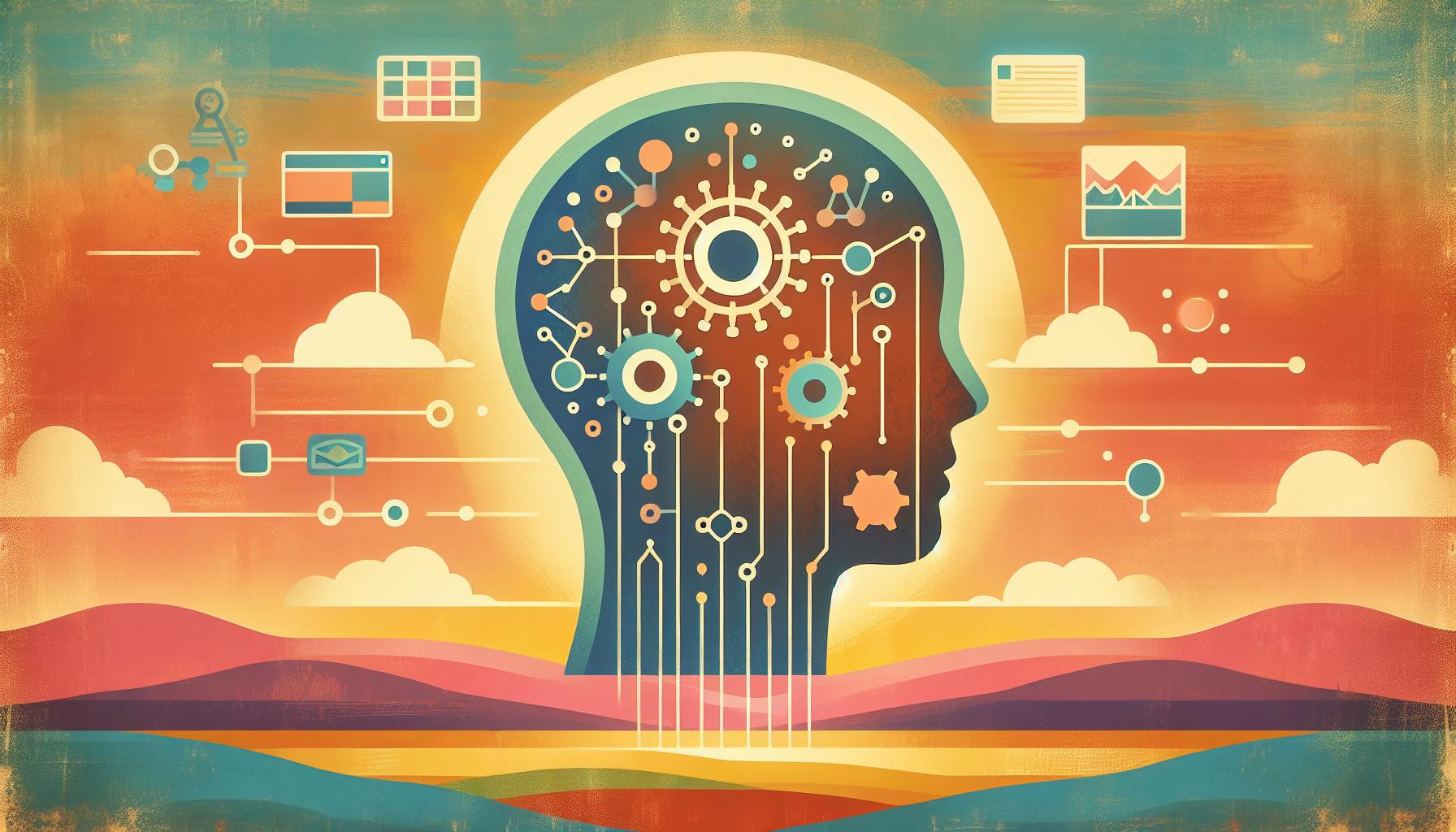Introduction: Unveiling AI's Role in Chat Interaction Evolution
Artificial intelligence is revolutionizing how we interact with technology, especially in the domain of conversational chatbots. AI enables more natural, contextual, and personalized conversations that were not possible before.
Exploring the Landscape of AI Applications Examples
Artificial intelligence (AI) refers to computer systems that can perform tasks that typically require human intelligence. Key subsets like machine learning and natural language processing (NLP) allow machines to improve at tasks through experience and understand nuances in human languages respectively.
Chatbots are computer programs designed to have conversations with humans using NLP. AI advancements are making chatbots smarter by:
- Understanding context to provide relevant responses
- Personalizing conversations based on user data
- Handling more complex dialogs
This improves user experience by making conversations more efficient, intuitive and life-like.
Assessing the Impact of Artificial Intelligence Examples in Current Chat Technologies
While today's chatbots can have basic conversations, most still face limitations in fully understanding natural language, remembering context, and providing truly personalized responses tailored to the individual.
AI has the potential to create more advanced chat experiences by:
- Enhancing context awareness to follow conversation flows
- Analyzing user data to serve hyper-relevant information
- Continuously learning from conversations to handle more complexity
As more impactful AI applications emerge, we inch closer to chat interactions that feel like fluid human-to-human dialogues customized to each user.
What are the three applications of AI in real life?
AI technology has been integrated into a wide range of real-world applications such as automated chatbots for customer support, image recognition systems for security purposes, and AI-based algorithms for personalizing shopping recommendations. These innovations help businesses, organizations, and even individuals boost efficiencies, increase convenience, and derive actionable insights from massive datasets.
Automated Chatbots for Improved Customer Service
Chatbots are powerful AI applications that harness natural language processing to understand customer queries and respond accordingly. Brands integrate them onto websites and mobile apps to offer 24/7 customer support.
For instance, several e-commerce shops use AI-powered bots to handle order tracking requests, product recommendations, shipping status updates and other routine customer concerns. This frees up human customer care agents to focus on issues that require emotional intelligence. Customers are now able to get instant responses from conversational bots rather than waiting on hold for agents.
Image Recognition for Enhanced Security
Computer vision technology powered by AI can automatically analyze images and videos to detect objects or patterns.
Sophisticated image recognition systems are being used across various sectors for security purposes. For example, facial recognition helps law enforcement authorities and airports identify criminals or terror suspects by matching face images against criminal databases. Similarly, AI scans CCTV feeds to detect intruders, suspicious behavior or safety violations at retail stores, offices, and public spaces.
Such AI-based computer vision helps authorities take preventive measures, avoid security risks, and ensure public safety.
AI-Driven Personalized Recommendations
E-commerce websites are increasingly using AI and machine learning algorithms to study buyer behavior and preferences. The systems derive actionable insights to predict what shoppers may be interested in purchasing.
For example, when customers browse for apparel or accessories online, AI recommends similar clothing items based on their browsing history and past purchases. This personalized experience helps shoppers discover relevant products easily. At the same time, it helps retailers boost sales through targeted recommendations.
The applications mentioned above are transforming industries and enhancing efficiencies across sectors. As AI technology evolves, businesses will unlock more innovative use cases that streamline operations as well as enrich customer experiences.
What AI is used in daily life?
Artificial intelligence is being integrated into many aspects of daily life through a variety of applications and devices. Some of the most common examples of AI that people interact with regularly include:
AI-Powered Assistants
As mentioned in the section context, AI assistants like Siri, Google Assistant, and Amazon Alexa are built into smartphones, speakers, and other devices. These act as personal assistants that can understand natural language requests to perform tasks like:
- Setting reminders and calendar events
- Answering questions by searching the internet
- Controlling smart home devices
- Playing music or podcasts
- Sending messages or making calls
- Getting weather or traffic updates
- And much more
These assistants use natural language processing and speech recognition to understand spoken requests and respond appropriately. Over time, they continue to learn the user's preferences with machine learning algorithms.
Smart Device Recommendations
Many apps and websites, like Netflix, Spotify, Amazon, YouTube, etc. use AI to provide personalized recommendations. Based on user data and activity, they can suggest content that aligns with someone's tastes and interests. This enhances the experience by surface relevant suggestions versus generic promoted items.
Autonomous Vehicles
Self-driving car technology relies heavily on AI and machine learning. Sensor data feeds into AI models that can detect objects, read signs and signals, navigate routes, and ultimately perform the driving task without human operation. Companies like Tesla, GM, and Waymo are advancing autonomous vehicles using deep neural networks. As the technology improves, it has the potential to prevent accidents and transform transportation.
So in summary, AI is becoming deeply embedded into common devices and services to provide more personalized, responsive, and helpful experiences in daily life. As the capabilities of AI continue to grow, people can expect even more ways it will assist them with tasks and decisions.
What are the 4 types of AI examples?
Some of these types of AI aren't even scientifically possible right now. According to the current system of classification, there are four primary AI types: reactive, limited memory, theory of mind, and self-aware. Let's take a look at each type in a little more depth.
Reactive Machines
These are the most basic types of AI systems which simply react to the current situation without taking historical data into account. They analyze sensor data, compare it to predefined rules, and take action based on that.
Examples include AI thermostats like Nest, robots that avoid obstacles, and chatbots that generate a response based on the user's input without any memory of past conversations.
Limited Memory
Unlike purely reactive AIs, limited memory systems can use previously stored information to inform future actions. However, these systems have a fixed storage capacity which means they only "remember" a limited timeframe.
Some examples are self-driving cars that map surroundings to navigate roads safely and digital assistants like Siri that can utilize information from previous commands.
Theory of Mind
An extremely advanced level that even human intelligence has yet to fully achieve, AI with theory of mind would be able to understand emotions, predict behavior, and recognize beliefs unlike anything we've created so far. This would enable complex social interactions.
While still hypothetical, some promising applications could be AI companions for the elderly and mental health chatbots that can understand users' feelings.
Self-Aware
Similar to the human level of consciousness, self-aware AI would have a strong sense of identity and the advanced ability for abstract thought, introspection, and self-improvement.
Considered potentially dangerous if priorities become misaligned with human values, researchers are exploring safeguards like allowing AI to question its actions while avoiding uncontrolled recursive self-improvement.
sbb-itb-b2c5cf4
Can you give any examples of AI?
Artificial intelligence is rapidly transforming many aspects of our daily lives. From virtual assistants like Siri and Alexa to recommendation engines on Netflix and Amazon, AI is powering more intuitive, personalized, and efficient digital experiences.
Some of the most common examples of AI applications include:
-
Smart assistants like Apple's Siri, Amazon's Alexa, Google Assistant, and Microsoft's Cortana use natural language processing to understand verbal commands and respond to queries. They rely on machine learning to continuously improve their capabilities.
-
Chatbots and customer service bots utilize natural language capabilities and sentiment analysis to provide automated support on websites and messaging apps. They can answer common questions and route inquiries to human agents when needed.
-
Recommender systems on platforms like YouTube, Netflix, Spotify etc. learn user preferences and suggest personalized content that aligns with individual interests and tastes. This enhances user engagement.
-
Computer vision powers facial recognition, image classification, augmented reality filters etc. It allows apps like Google Photos to auto-tag images by detecting objects and scenes. Self-driving cars also leverage computer vision to recognize road signs, pedestrians, other vehicles etc.
As AI capabilities continue advancing, more impactful and specialized applications will emerge across industries - from healthcare and finance to transportation and manufacturing. But even in its current state, AI is streamlining interactions and optimizing experiences for millions of users worldwide.
5 Applications of AI Elevating Chatbot Interactions
Artificial intelligence is revolutionizing how we interact with chatbots, enabling more natural conversations that meet our needs. As AI continues advancing, here are 5 key applications enhancing chatbot capabilities:
Enhancing Understanding with Natural Language Processing
Natural language processing (NLP) techniques like BERT are empowering chatbots to better comprehend user intents through semantic analysis. Instead of relying on rigid commands, chatbots can now identify ai applications examples with more contextual nuance. This improves the accuracy of intent classification and entity extraction, allowing for more dynamic conversations.
For instance, an AI-powered chatbot on an ecommerce site can understand shopper questions and match them to appropriate product pages. Rather than needing an exact keyword match, the NLP model can discern meaning from related queries. This provides a smoother user experience.
Sophisticated Dialogue Management through Sequential Models
Sequential models like seq2seq are enabling more advanced dialogue management. Chatbots can now track context across long conversations, while adjusting responses appropriately.
With sequential modelling, chatbots ask better follow-up questions based on previous dialogue history. The AI assistant also avoids repetitive suggestions and remembers user preferences, boosting personalization.
Overall, this sequential approach mimics human conversation patterns more closely. Users enjoy a tailored experience suited to their needs.
Generating Dynamic Responses with AI Language Models
Cutting-edge AI language models are powering more dynamic chatbot responses. Instead of pulling from a limited set of pre-programmed replies, chatbots can now generate original sentences on-the-fly.
Models like GPT-3 produce remarkably human-like responses based on the dialogue context. While not perfect, such AI-generated text creates more engaging and helpful conversations.
As these large language models continue evolving, users can expect ever more natural chats with chatbots. The possibilities are exciting!
Speech Recognition Technologies
With speech recognition, chatbots can now understand spoken commands and questions too. Users can interact hands-free by voice, enjoying greater accessibility and convenience.
From voice assistants to IVR phone bots, speech recognition is a game-changer. As the underlying AI gets more accurate at transcribing speech, especially with context, voice bots become easier to use.
This allows brands to serve customers across more channels, while users can multitask during conversations. Voice interaction enriches the chatbot experience.
Leveraging Sentiment Analysis for Emotional Intelligence
By detecting emotional signals in text, chatbots can respond more empathetically. Sentiment analysis tools identify attitudes, opinions and feelings within conversations.
The chatbot can then tailor its tone and suggest appropriate solutions for the user's current emotional state. This emotional intelligence helps strengthen rapport and satisfaction.
As sentiment analysis improves, chatbots will become better at sensing moods and engaging users on a more personal level.
In summary, advanced AI is enabling more efficient, intuitive and delightful chatbot interactions. As these technologies continue evolving, chatbots promise to revolutionize customer engagement across industries. The future looks bright for more meaningful bot conversations!
Case Studies: Examples of Artificial Intelligence in Business Chatbots
Artificial intelligence is revolutionizing business chatbots, enabling more natural conversations and insightful experiences. As highlighted in the article headline, AI applications examples are transforming chat interactions across industries.
Let's explore some real-world case studies of companies utilizing AI to enhance chatbot capabilities. These examples demonstrate the practical impact such advancements in artificial intelligence are having on business communication.
Elevating eCommerce Chatbots with AI
Ecommerce brands like Home Depot, Sephora, and North Face use natural language understanding (NLU) and dialogue management models to create personalized shopping experiences through their chatbots.
For example, Sephora's chatbot can recommend products best suited for a shopper's skin type and color preferences. By leveraging AI for contextual recommendations, Sephora boosts average order value by 11%.
Similarly, Home Depot uses AI to understand complex customer queries about home improvement projects. Their chatbot then provides helpful step-by-step advice using 3D interactive images. This functionality increased sales leads by 70%.
These implementations showcase how AI-enabled chatbots are shaping the future of customer experience - meeting buyers on their channel of choice with intuitive conversations.
Innovating Healthcare Support with Conversational AI
Innovators in the healthcare industry are turning to conversational AI to provide better patient support while reducing costs.
For instance, Florence is a virtual nurse chatbot that uses speech recognition and natural language capabilities to have meaningful dialogues with patients. It can answer common medical questions, take down notes of symptoms, arrange doctor appointments, and more.
Babylon Health is another pioneer, using emotion detection in their chatbot to show empathy in patient interactions. This level of emotional intelligence strengthens trust and relationships.
Such AI applications are increasing access to healthcare info and resources. Early testing shows 60% of patient needs can be resolved by AI chatbots without human intervention.
Transforming Customer Support with Best AI Apps
Examples of artificial intelligence in business are most prominent in customer support chatbots. AI powers fast, accurate self-service, so human agents can focus on complex issues.
For example, the IKEA chatbot handles ~70% of customer conversations using NLU to parse questions and a knowledge graph to provide answers. Thoughtful features like typo tolerance and context switching make conversations smoother.
Similarly, the Four Seasons Hotel chatbot delivers exceptional hospitality using AI. It greets guests by name, answers common accommodation queries, and even tells jokes! This helps staff avoid repetitive tasks so they can better cater to visitor needs.
As these examples showcase, AI chatbots are fundamentally transforming businesses across sectors. Conversational AI unlocks more personalized, efficient and overall improved communication experiences.
Best AI Apps: Crafting Intelligent Chatbots
Artificial intelligence is revolutionizing how we interact with technology. AI chatbots powered by large language models are becoming increasingly common across industries, providing more natural conversations and efficient automated assistance. When developing AI chatbots, it's important to follow best practices around training data, explainability, and testing.
Curating Diverse Training Datasets for AI Chatbots
High-quality training data is key for creating capable and robust AI chatbots. The model's understanding is shaped by the conversational data it's trained on. Collecting varied datasets across different topics, formats, and complexity levels is crucial. This diversity empowers chatbots to handle more real-world queries. Prioritizing diversity also reduces biases that could negatively impact certain demographics.
Ideally, training data should cover an extensive range of potential conversational scenarios the chatbot may encounter. Using fabricated data limits the model's effectiveness in production environments. Real anonymized customer conversations are best for accurately reflecting how people naturally communicate. Continuously expanding datasets further enhances versatility. Overall, thoughtful curation of diverse training data gives AI chatbots the foundation to deliver satisfactory experiences.
Prioritizing Explainability in AI Chatbot Development
While performance metrics provide insight into an AI chatbot's capabilities, explainability is also vital. Interpreting model behavior builds understanding of its strengths and limitations. Analyzing attention patterns reveals how chatbots associate queries with responses, uncovering potential gaps in understanding.
Explainability also enables identifying biases that could cause issues. With interpretable model internals, problematic associations stemming from skewed training data can be pinpointed and addressed.
Enhancing explainability ultimately builds user trust. Demonstrating how chatbots logically determine responses reassures users their experience improve over time. Transparency also aids troubleshooting when conversations go awry. Prioritizing explainability is thus key for developing reliable, ethical AI chatbots.
Ensuring Chatbot Efficacy through Rigorous Testing
After training robust models, rigorous testing across diverse use cases is required to validate AI chatbot efficacy. While metrics on training data reflect potential, effectiveness in real applications may differ. Thorough testing uncovers performance gaps not detectable from metrics alone.
Testing suites should cover an extensive range of conversational scenarios, emulating natural dialogue patterns. Using real anonymized customer conversations to synthesize new test cases improves coverage of real-world variability. Testing on skewed or synthetic data risks overestimating production readiness.
Continuous deployment of incremental versions enables comparing performance empirically. Testing also facilitates benchmarking between models to select the best fit. Overall, rigorous testing provides confidence in chatbot capabilities prior to release, ensuring satisfactory end-user experiences.
Envisioning the Next Wave of AI Chat Interaction
Custom AI applications integrated with ChatGPT will enable more natural conversations between humans and AI assistants. As chatbots advance, they will likely exhibit improved common sense reasoning and personalization.
Toward More Human-like Conversational Experiences
Future iterations of chatbots may showcase more nuanced language capabilities and interpersonal skills, leading to interactions that feel increasingly natural. We may see bots that:
- Understand and respond appropriately to complex questions and commands
- Maintain context and memory throughout long conversations
- Express empathy, humor, and other emotional intelligence traits
- Adapt speaking styles and vocabulary tailored to each user
With steady progress, chatbots will become adept conversationalists on par with humans.
From Chatbots to AI Virtual Assistants: A Paradigm Shift
Chatbots have already evolved from simple Q&A tools to AI assistants capable of managing workflows and automating tasks. We are witnessing an impactful paradigm shift as these bots transform into sophisticated helpers that:
- Proactively surface important information
- Provide timely reminders and recommendations
- Complete web searches, schedule meetings, purchase items, and handle other chores
Soon, AI virtual assistants may feel like an extension of our own minds - tireless aides that help us work smarter and maximize productivity.


